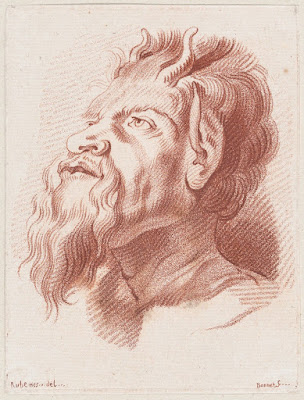 |
| Benjamin Zager What omnious [sic] thunderous devine [sic] force causes mine suffering head and eyes too [sic] resurrect heavenwards 1937 gouache on paper Philadelphia Museum of Art |
 |
| Richard Earlom after Salvator Rosa The Prodigal Son 1766 etching Metropolitan Museum of Art, New York |
 |
| Louis-Marin Bonnet after Peter Paul Rubens Head of Satyr ca. 1770 engraving Metropolitan Museum of Art, New York |
 |
| Gilles Demarteau after François Boucher Head of Youth ca. 1765 engraving Metropolitan Museum of Art, New York |
 |
| Julio González Solemn Head in Profile 1942 drawing, with watercolor Tate Gallery |
 |
| Dirk Helmbreker Head of Young Man ca. 1660 drawing National Gallery of Art, Washington DC |
 |
| Francesco di Maria Head of Man wearing a Helmet before 1690 drawing Metropolitan Museum of Art, New York |
 |
| Willem Panneels Study of Antique Head ca. 1628-30 drawing Statens Museum for Kunst, Copenhagen |
 |
| Anthony van Dyck Study Head of St John the Evangelist ca. 1620 oil on panel National Gallery of Norway, Oslo |
 |
| José Vallejo Head Study ca. 1875 oil on canvas Museo del Prado, Madrid |
 |
| John Hamilton Mortimer King Lear in the Storm 1776 etching Yale Center for British Art |
 |
| Alphonse Legros Head of an Italian Model 1878 drawing Princeton University Art Museum |
 |
| Francisco Goya Head of Angel ca. 1771-72 drawing Musée du Louvre |
 |
| Gaetano Gandolfi Head of Saint ca. 1785 etching Philadelphia Museum of Art |
 |
| Alexandre Cabanel Study of Head ca. 1870 drawing Morgan Library, New York |
 |
| Gaetano Giulio Zumbo Blessed Soul ca. 1700 colored wax relief Victoria & Albert Museum, London |
"They left the car park and passed through the great glass doors with their chrome portico into the atrium of the mall, where glass escalators ascended in constant rotation through three floors to the transparent dome of the roof, so that all the layers of the building could be seen from below. It was like an illustration of the chambers of the heart, people were carried upwards by the escalators, eventually to re-emerge, oxygenated by shopping. At the centre of the main hall, a huge fountain steadily pumped out its jet of water amidst fronded networks of plants, and bunches of coloured balloons drifted silently around on their tethers as though they were suspended in liquid. A steady level of mysterious hydraulic sound filled the echoing, daylight-coloured spaces, though there was music running just beneath the surface of it and human noises, strangely muffled and indistinct, like a commotion heard under water: the rise and fall of voices that came in loops and sudden reports, the piercing, shrill call of babies, the syncopated hoots and shrieks of rubber shoes on the tiled floors, and the spontaneous mechanical birdsong of mobile phones. The place was full of people, on the escalators, all along the glass-fronted galleries, milling in the broad avenues that led off the main hall; yet the strange acoustics and saturating, glassy light deadened the sense of human congress, so that they seemed almost to be swimming or floating rather than walking. The conditioned air negated the smell of bodies. Instead, the atmosphere was divided into invisible regions of perfume, and a continuous odour of coffee and baking stood around the open-air cafés like a replacement for walls and language."
– Rachel Cusk, from the novel Arlington Park (2006)